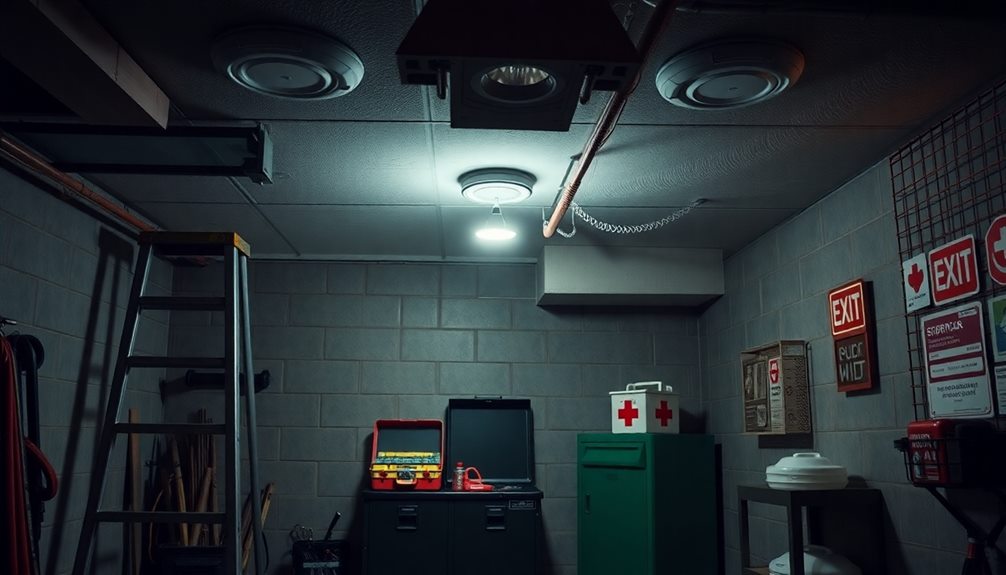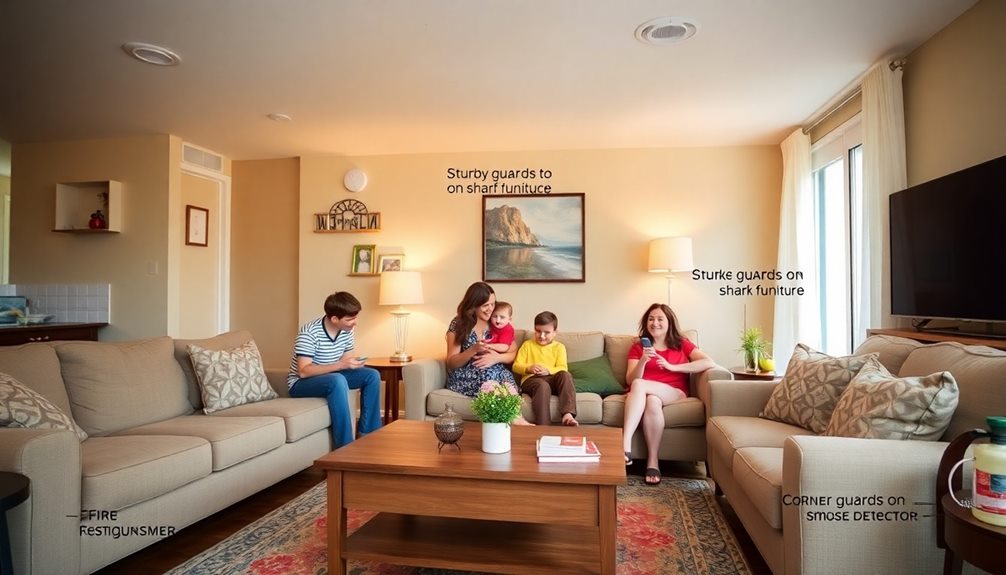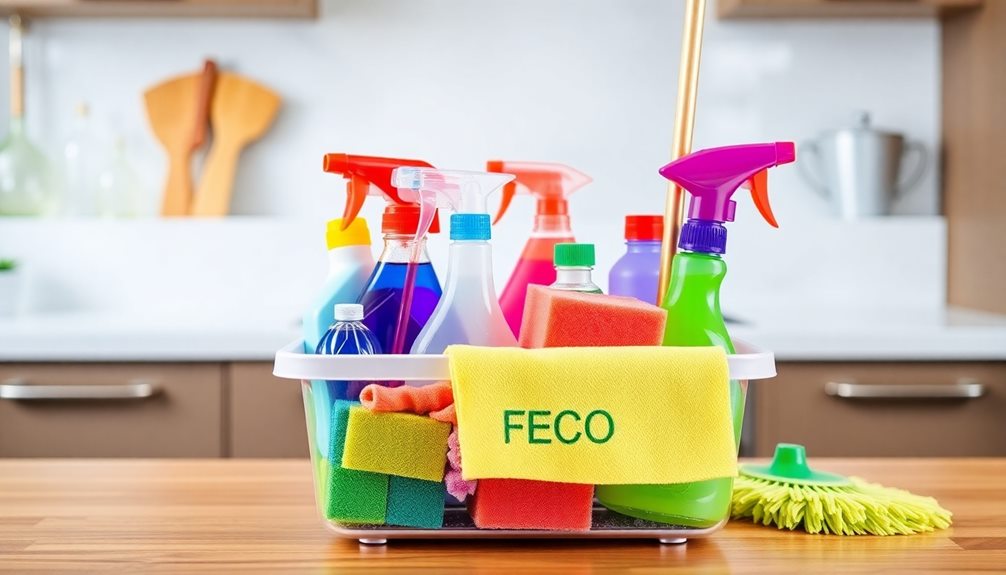To keep your home safe, start with a room-by-room checklist. In the kitchen, inspect appliances and install carbon monoxide detectors. For bathrooms, look for leaks and add non-slip mats. Check your basement's breaker and maintain your HVAC system. In hallways, secure rugs and guarantee good lighting. Living spaces should be free of tripping hazards, and outdoor areas need gate checks and tree pruning. Don't forget to plan for emergencies and enhance security with deadbolts and motion sensors. Follow these guidelines, and you'll find even more ways to protect your home and loved ones.
Key Takeaways
- Install smoke detectors on every floor and test them monthly to ensure functionality and safety.
- Maintain a well-stocked emergency kit with essential supplies for at least three days.
- Regularly inspect kitchen appliances and electrical circuits to prevent hazards.
- Secure rugs and paths to minimize tripping hazards in hallways and living spaces.
- Implement home security measures like deadbolts and motion detection sensors for enhanced safety.
Kitchen Safety Checklist
The kitchen is often the heart of the home, but it can also be a hotspot for safety hazards if not properly maintained. To guarantee your kitchen remains safe, regularly inspect your kitchen appliances for any signs of damage or improper installation. Faulty appliances can lead to serious fire hazards, so it's vital to address issues promptly.
Additionally, be mindful of any food items that could pose risks to pets, such as the dangers of raisins for dogs, which can inadvertently be left within reach.
Next, verify your range hood and exhaust fan are vented and cleaned regularly to prevent grease buildup, which increases fire risk. Install smoke detectors and carbon monoxide detectors in the kitchen and on every floor, testing them monthly to confirm they're functioning. These devices are essential components of your home safety system.
Don't forget about your water quality; check and replace water filters at least every six months to ensure access to clean drinking water.
Also, avoid overloading electrical circuits—consult an electrician to set up dedicated circuits for high-wattage appliances, keeping electrical fires at bay.
Bathroom Safety Checklist

Guaranteeing bathroom safety is vital for maintaining a healthy home environment. Start your bathroom safety checklist by inspecting pipes for signs of rust, corrosion, or leaks. These issues can lead to water damage and health hazards.
Every six months, test your faucets and toilets to verify they operate correctly and check for leaks to conserve water. Additionally, consider using an air purifier to enhance air quality and reduce allergens that may accumulate in bathroom spaces.
Next, clean showerheads regularly to maintain ideal water pressure and eliminate bacteria buildup. It's fundamental for your hygiene.
Pay attention to the caulking around the shower, tub, and sinks; any discoloration or cracks can be a sign of mold that needs immediate attention.
To prevent slips and falls, consider installing non-slip bath mats and grab bars. These additions provide stability and safety, especially for children or elderly family members.
Finally, familiarize yourself with the location and functionality of the main shut-off valve. In case of an emergency plumbing issue, this knowledge can minimize damage and protect your home.
Basement Safety Checklist

When it comes to home safety, basement areas often get overlooked, yet they play a significant role in your overall well-being. To guarantee your basement is safe and efficient, follow this checklist.
| Task | Frequency |
|---|---|
| Inspect main breaker | Monthly |
| Flush water heater | Annually |
| Clean air ducts | Every six months |
| Change HVAC air filters | Every three months |
Familiarize yourself with your home safety system by labeling the main breaker controls for quick access during emergencies. Regular inspections of your HVAC system will promote efficiency and prevent unexpected failures in heating and cooling.
Don't forget about your water heater—flushing it annually will help remove sediment buildup, reducing the risk of leaks. Additionally, cleaning air ducts and vents regularly minimizes allergens and fire hazards, improving air quality throughout your home.
Lastly, consider reviewing your home insurance policy to guarantee you're covered for any potential basement-related incidents. By taking these steps, you'll maintain a safe and healthy environment in one of your home's most common household areas.
Hallway Safety Checklist

Your hallway's safety is vital for preventing accidents and guaranteeing a smooth flow through your home. Start by following this hallway safety checklist.
Regularly check for loose rugs that could cause trips. Secure them with non-skid tape or mats to minimize hazards. Incorporating elements of modern farmhouse decor can't only enhance the aesthetic appeal but also promote a safer environment with functional designs.
Installing night lights with motion sensors is a great way to enhance visibility during nighttime, helping you navigate safely.
Next, keep your pathways clear. Trim any overgrown plants or trees that might obstruct light or movement. This guarantees you won't trip over anything unexpected.
Periodic inspections for loose floorboards or carpet edges are vital, as they greatly reduce the risk of slips and falls.
Don't forget about electrical hazards. Regularly inspect your hallway outlets and replace any missing or damaged outlet covers. This simple step protects against potential shocks and accidents.
Living Spaces Safety Checklist

A safe living space is essential for preventing accidents and guaranteeing comfort in your home. Start by removing tripping hazards; secure loose rugs and keep pathways clear. This will help you avoid falls and injuries.
Install nightlights with motion sensors in hallways and living areas for better visibility at night—this simple step can considerably reduce accident risks.
Next, conduct regular inspections of your furniture. Make sure items like bookshelves and cabinets are anchored to the wall to prevent tipping.
Keep electrical cords organized and away from high-traffic areas to minimize tripping hazards and reduce the risk of common fire incidents.
Incorporate first aid kits into your home safety system. Having a stocked first aid kit readily available gives you peace of mind and guarantees you're prepared for minor injuries.
Outdoor Safety Checklist

Outdoor safety is essential for protecting your property and loved ones. Start by regularly inspecting your roof for cracked or missing shingles; this can prevent water leaks and costly structural damage.
Don't forget to clean your rain gutters and downspouts frequently, as clogged gutters can lead to water damage and mold growth.
Next, check all gates to confirm they're functional and secure with working latches. This added security can deter unauthorized access and keep your family safe.
Prune trees and shrubs around your property to eliminate hiding spots for potential intruders, maintaining clear visibility.
Store dangerous household items like fertilizers and chemicals in locked cabinets or high places, making them out of reach of children and pets.
Additionally, make certain your window and door locks are in good working condition to enhance your home security system.
Regularly review this outdoor safety checklist to keep your environment secure and safe for everyone.
Emergency Preparedness Steps

While securing your outdoor space is essential, being prepared for emergencies inside your home is equally important. Start by installing smoke detectors on every floor and in sleeping areas. Test them monthly and replace the batteries annually to keep your home safe.
Next, create an emergency contact list that includes family members, local emergency services, and poison control. Post this list in a visible spot, like your fridge, so everyone knows where to find it.
Assemble a thorough emergency kit containing at least three days' worth of non-perishable food and water, a flashlight, batteries, and a first aid kit. This guarantees you're ready for any unexpected situation.
Additionally, develop and practice an escape plan that outlines multiple exits from your home and a designated meeting spot outside. Make sure all family members are familiar with it.
Lastly, stay informed about potential natural disasters by regularly reviewing local weather forecasts and alerts. This allows you to prepare and evacuate if necessary, keeping your family safe during emergencies.
Home Security Measures

Securing your home is essential for protecting your loved ones and belongings from potential threats. Implementing effective home security measures can greatly reduce the risk of break-ins. Did you know that homes without security systems are 300% more likely to be broken into?
Start with installing deadbolts on all exterior doors. These provide better resistance against forced entry. Consider adding motion detection sensors to alert you of intruders, allowing for quicker responses. Video doorbell cameras not only monitor visitors but also deter criminal activity through visible surveillance.
To guarantee you're on top of your home security, regularly update and test your security systems, including alarms and cameras, to maintain peak protection.
Here's a quick reference table to help you remember key security features:
| Security Measure | Purpose |
|---|---|
| Deadbolts | Enhance resistance against forced entry |
| Motion Detection Sensors | Alert homeowners of potential intruders |
| Video Doorbell Cameras | Monitor visitors and deter crime |
| Security Systems | Provide thorough protection |
Frequently Asked Questions
What Are Common Household Hazards to Look For?
Common household hazards include slippery floors, exposed wires, cluttered walkways, and chemicals stored improperly. You should check for smoke detectors, carbon monoxide alarms, and verify your fire extinguishers are accessible and functional to enhance safety.
How Often Should I Update My Safety Checklist?
You might feel secure now, but don't let complacency creep in. Update your safety checklist at least twice a year or whenever significant changes occur in your home. Stay proactive to guarantee ongoing safety.
Are There Safety Devices I Can Install Myself?
Yes, you can install several safety devices yourself. Consider smoke detectors, carbon monoxide alarms, and security cameras. Just follow the manufacturer's instructions, guarantee proper placement, and test each device to confirm they're functioning correctly.
How Can I Teach Children About Home Safety?
You might wonder how to instill a sense of safety in your children. Start with engaging discussions, role-playing scenarios, and fun activities that highlight hazards. This way, you'll empower them to recognize and avoid dangers effectively.
What Should I Do if I Find a Safety Issue?
If you find a safety issue, address it immediately. Assess the severity, and if it's serious, call a professional. Fix minor problems yourself, but always prioritize your safety and guarantee it won't happen again.
Conclusion
By taking the time to go through this room-by-room safety checklist, you're investing in your family's well-being. You might think it's overwhelming, but breaking it down into manageable tasks makes it easier. After all, a safe home doesn't just protect your possessions; it safeguards your loved ones. So, roll up your sleeves and tackle one area at a time. You'll feel more secure and confident in your space, knowing you've done everything you can to keep them safe.










